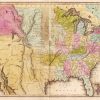calsfoundation@cals.org
The Desperadoes of the South-West: Containing an Account of the Cane-Hill Murders, Together with the Lives of Several of the Most Notorious Regulators and Moderators of that Region
Originally published in 1847, The Desperadoes of the South-West: Containing an Account of the Cane-Hill Murders, Together with the Lives of Several of the Most Notorious Regulators and Moderators of that Region was a book written by Alfred W. Arrington (1810–1867), who was an attorney, judge, and Arkansas state legislator.
As a resident of Fayetteville (Washington County), Arrington heard about the brutal murders in nearby Cane Hill (Washington County) that had taken place in 1839. As an attorney, he felt that the subsequent executions by vigilantes of four men who were accused of the crime constituted a lynching. The book he produced as a result, The Desperadoes of the South-West, has been called highly romanticized, but Arrington indicated that, in his opinion, the men who were hanged had been innocent.
The basic facts of the Cane Hill murders are that William Carter Wright and four of his children were murdered in their home at Cane Hill on June 15, 1839. Citizens’ vigilante groups were not unknown in the far northwestern region of Arkansas, as it was a border area with little organized law enforcement. One group of men, calling themselves Cane Hill Independent Regulating Company, took it upon themselves to respond to the brutality of the murders. Instead of a legal trial, the vigilante group conducted its own investigation in which four men, John Richmond, James Barnes, Jackson Turner and William Bailey, were accused of the crime. Bailey was not captured until later that year. The suspects were not permitted to face their accusers, and it was reported that the accused men had alibis for the night of the murder. However, their pleas of innocence were ignored. Richmond attempted to escape from the vigilantes but was captured. His confession, allegedly brought about by being whipped and beaten during questioning, was used in evidence against all of the accused men. The three men were lynched on July 29, 1839, near Cane Hill. William Bailey escaped the vigilantes but was caught and hanged in December 1839.
Arrington made a case for the innocence of the accused men who were executed by the vigilantes. Arrington claimed that, two years after the lynchings, a pair of Native Americans came to Fayetteville, allegedly confessing that they were the ones who had killed the Wright family.
As noted in Arrington book’s title, there is also mention of “Regulators” and “Moderators.” These terms are not often used in modern times, although they were well-known during the late 1700s and early 1800s. “Regulators” were settlers in western regions who felt they were being treated unfairly by the Eastern-dominated government. Regulators were especially angry about what they considered to be high taxes, illegal fees, poor services, and corrupt officials. Their outrage often resulted in taking matters into their own hands in order to “regulate” the injustices of the governmental system. They did this through violent acts against the government as well as fellow citizens. Uprisings by the Regulators were opposed by a group calling themselves “Moderators,” who resented the Regulators’ use of violence. Moderators sought to “moderate” issues through peaceful means, although they sometimes became involved in skirmishes with the Regulators. As the United States continued to move westward, and areas like northwestern Arkansas ceased to be the border of the “wild frontier,” law enforcement became more standardized. Regulators and Moderators faded out, with vigilante justice becoming less prevalent.
For additional information:
“Alfred W. Arrington, Strangers to Us All: Lawyers and Poetry.” LawLit.net. https://lawlit.net/lp-2001/arrington.html (accessed May 9, 2025).
Arrington, Alfred W. The Desperadoes of the South-West: Containing an Account of the Cane-Hill Murders, Together with the Lives of Several of the Most Notorious Regulators and Moderators of that Region. New York: W. H. Graham, 1847. Online at https://archive.org/details/GR_95 (accessed May 9, 2025).
Williams, Charles G. “The Cane Hill Murders of 1839 in History and Literature.” Arkansas Historical Quarterly 29 (Autumn 1970): 209–214.
Worley, Ted R. “The Story of Alfred W. Arrington.” Arkansas Historical Quarterly 14 (Winter 1955): 315–339.
Nancy Hendricks
Garland County Historical Society





Comments
No comments on this entry yet.